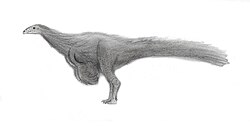Nqwebasaurus
|
Nqwebasaurus Temporal range: Early Cretaceous, 140 Ma |
|
|---|---|
 |
|
| Life restoration | |
| Scientific classification | |
| Kingdom: | Animalia |
| Phylum: | Chordata |
| Class: | Reptilia |
| Clade: | Dinosauria |
| Order: | Saurischia |
| Suborder: | Theropoda |
| Clade: | †Ornithomimosauria |
| Genus: |
†Nqwebasaurus de Klerk et al., 2000 |
| Species: | †N. thwazi |
| Binomial name | |
|
Nqwebasaurus thwazi de Klerk et al., 2000 |
|
Nqwebasaurus (IPA: [ᵑǃʷɛbaˈsɔɹəs] with an initial postalveolar nasal click; anglicized as /ənkwɛbəˈsɔːrəs/) is the name given to a genus of dinosaur sometime between the Tithonian to Valanginian (Late Jurassic to Early Cretaceous). It was the basalmost ornithomimosaur. Its fossils were found in South Africa in the Kirkwood Formation, which is called Nqweba in the native language of the Xhosa. It was nicknamed "Kirky" after this formation before receiving its scientific name.Nqwebasaurus is the earliest known coelurosaur from Gondwana, pre-dating other known North African taxa by 50 million years. It is also the first coelurosaur to be discovered and named from Africa.
The type species, Nqwebasaurus thwazi, was described by de Klerk, Forster, Sampson, Chinsamy and Ross in 2000. According to the authors, the new genus is one of the "most complete and best preserved Cretaceous theropods described thus far from Africa." The well-preserved specimen had a long, three-fingered hand which included a partially opposable thumb (a "killer claw") The fossil also contained gastroliths in its stomach. The specimen appeared to be a late juvenile about 30 cm (1 ft) high and around 90 cm (3 ft) long, though the length of its tail is not known.
...
Wikipedia
